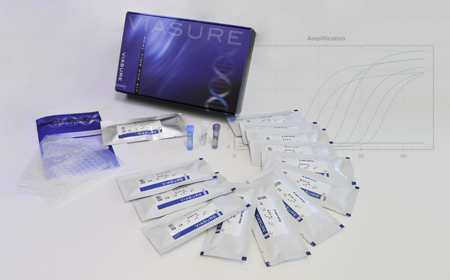
VIASURE Real Time PCR Detection Kits
H. influenzae + S. pneumoniae + M. catarrhalis

Description
VIASURE H. influenzae + S. pneumoniae + M. catarrahalis Real Time PCR Detection Kit is designed for the specific identification and differentiation of H. influenzae, S. pneumoniae and M. catarrahalis in respiratory samples from patients with signs and symptoms of respiratory infection.
This test is intended to be used as an aid in the diagnosis of H. influenzae, S. pneumoniae and M. catarrahalis in combination with clinical and epidemiological risk factors.
DNA is extracted from specimens, multiplied using Real Time amplification and detected using fluorescent reporter dye probes specific for H. influenzae, S. pneumoniae and M. catarrahalis.
Specifications
Information
Haemophilus influenzae, Streptococcus pneumoniae and Moraxella catarrhalis are the most common bacterial pathogens in upper and lower respiratory tract infections. Bacterial pathogens adhere to mucous membranes and colonization ensues. In an otherwise healthy individual the host immune system responds to the invading bacteria resulting in edema and swelling. If antimicrobial treatment does not eradicate the invading organisms and successfully interrupt the progress of the infection, the patient may develop recurrent or chronic disease.
Haemophilus influenzae, a pleomorphic gram-negative coccobacillus, is a common commensal of the upper respiratory tract. It is a human-only pathogen that can cause severe invasive disease, including meningitis, pneumonia, and septicemia. H. influenzae strains are divided based on the presence or absence of a polysaccharide capsule; there are 6 encapsulated serotypes (Hia–Hif) and nonencapsulated, nontypeable H. influenzae (NTHi) strains. Although Hib strains are considered the most pathogenic, NTHi accounts for a high proportion of all H. influenzae infections because it causes invasive infections, as well as, a notable number of noninvasive diseases, such as otitis media and sinusitis.
Streptococcus pneumoniae is the major pathogen implicated in community-acquired pneumonia (CAP) in adults and children. CAP is a major public health problem worldwide. Futhermore infections caused by this pathogen include meningitis, bacteremia, bronchitis, sinusitis, and otitis media. More than 90 different serotypes of S. pneumoniae have been identified to date on the basis of the biochemical structure of the capsular
polysaccharide that is a major virulence factor. The distribution of serotypes can vary with age, geography and time.
Moraxella catarrhalis is a human-restricted opportunistic bacterial pathogen of the respiratory tract. Although it is able to colonize asymptomatically, M. catarrhalis is also an important aetiological agent of otitis media (OM) in infants and children, and acute exacerbations of chronic obstructive pulmonary disease (COPD) in the elderly and heavy smokers. M. catarrhalis is acapsular and is the only serotyping system developed for the species to date that differentiates isolates by the structure of outer-membrane lipoologosaccharide (LOS). LOS is much less
heterogeneous (serotype A, B and C), thus, it is infrequently used for typing M. catarrhalis. The major genetic division of M. catarrhalis strains is based on the 16 S ribotyping method, which divides strains into three ribotypes (RB1, RB2 and RB3) divided into two lineages (RB1 and RB2/3) based on the sequence of the 16 S rRNA gene.
Several types of laboratory test are available for diagnosis of Haemophilus influenzae, Streptococcus pneumoniae and Moraxella catarrhalis. Culture is the gold standard to diagnose these pathogens. However, Real Time PCR assays have been shown to be a more sensitive and specific diagnosis tool for the detection of Haemophilus influenzae, Streptococcus pneumoniae and Moraxella catarrhalis.

